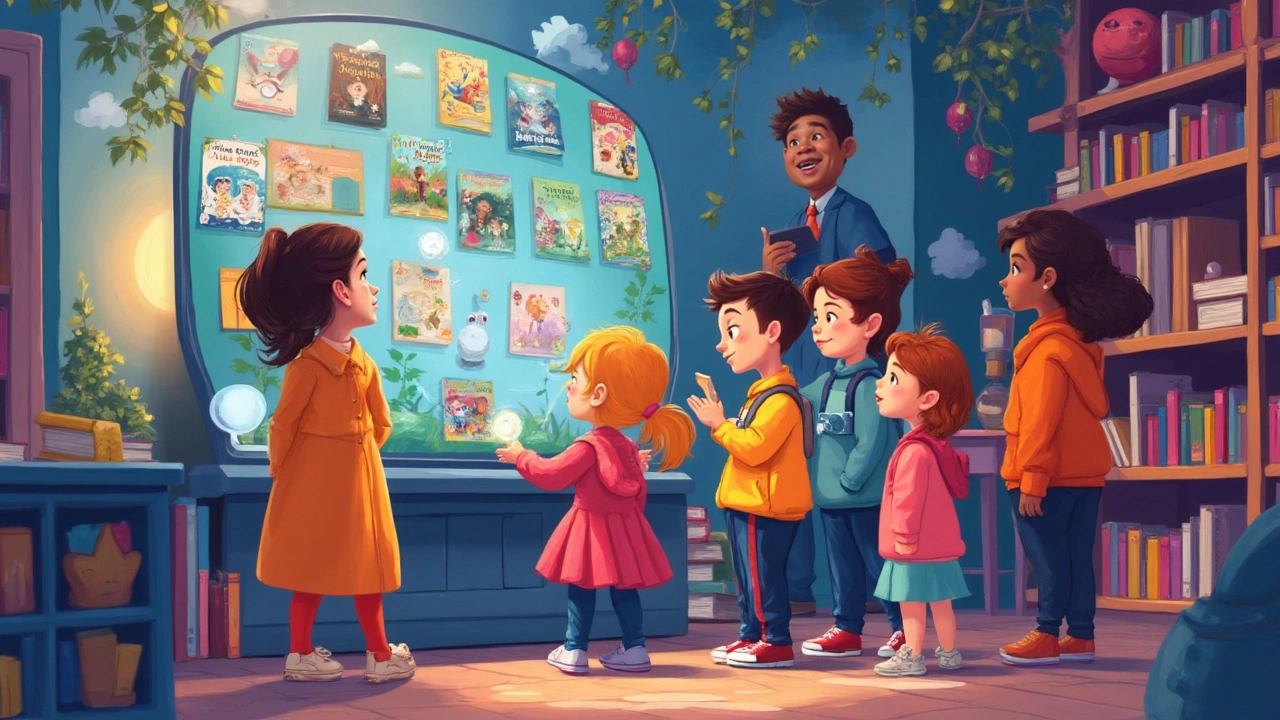Free Children's Book Reading Apps: Best Ways to Access Kids’ Books Online

Remember the thrill of discovering a magical world in a bedtime story? A talking animal here, a friendly robot there, and before you know it, a whole new universe opens up. Imagine if you could offer your child that same joy without ever having to buy a single book. Wild idea, right? But that’s the world we live in now. Apps have made storytime as simple as a tap. And—good news for parents—there are actually solid, legitimate apps where you can read children's books for free. I’ve lived through countless naptime negotiations and post-bath wind-downs with my cat Muffin watching judgmentally from the armchair, so when I say I’ve searched high and low for ways to score quality kids’ books without blowing a paycheck, I mean it.
Why Free Kids Book Apps Matter (and How They Work)
Parenting is already expensive. Between school supplies, dance lessons, and resupplying lost socks, it feels incredible whenever you stumble onto something truly valuable that costs nothing. Free children’s book apps aren’t just about saving cash, though. They can help get books into the hands of kids who have limited access to libraries or physical books—a huge deal, especially after schools switched to remote learning during the pandemic. Reading is the foundation for everything else academic, so these apps punch well above their weight.
Here’s how most free kids’ book apps work: They secure permissions from publishers or source books that are out of copyright. Think fairy tales, classic fables, and sometimes even modern titles if the right agreements are in place. Some apps use volunteers to record audiobooks, while others deliver slick, interactive experiences—think touchable illustrations, quizzes at the end, or simple animation that makes the cat in the story wiggle (Muffin, you’re still my favorite cat).
Something I appreciate is when a reading app is actually built with kids in mind, not just a repurposed grown-up ebook reader slapped with a cartoon giraffe on the loading screen. The best free children’s reading apps break books down by age or grade, let kids listen OR read along, and make the whole thing fun enough that you don’t need to beg your kid to pick up a ‘book’. Many even allow you to switch between languages—a big bonus if you want exposure to Spanish or Mandarin without paying for extra lessons.
Libraries have joined the digital party, too. Vancouver Public Library, for instance, lets you borrow children’s ebooks with just your library card and a decent Wi-Fi connection. Services like OverDrive and Libby act as middlemen, connecting you to whichever book your library has available—seriously, you’d be shocked at how much you can access once you try their kids’ section. And if you don’t have a library card, some communities (including tons in Canada) let you sign up online and start borrowing immediately.

The Most Popular Free Children's Book Reading Apps
Let’s jump right to the juicy part: what are the actual best apps for reading children’s books for free? Spoiler: there are more good ones than you expect, and they each have their own vibe.
- Epic! – Until recently, Epic! was a paid app, but you can now get limited free access every week. They claim over 40,000 titles, with read-to-me and interactive stories, making it a huge hit in classrooms and at home. Pro tip: teachers can set up a free classroom account and invite families.
- Libby/OverDrive – Your digital library card’s best friend. These apps connect straight to your local library (including Vancouver’s system) and lend you picture books, chapter books, and audiobooks. Availability varies, but new releases and old school classics are both there. You can even filter for “kids” and set parental controls.
- Storyline Online – Jackpot for anyone who likes picture books read by actual celebrities. Think Viola Davis reading “Rent Party Jazz” or Chris Pine with “Clark the Shark.” (And yes, it is ALL free.)
- Wattpad Kids – If you’ve got an older child or a tween, Wattpad’s collection offers user-created stories, and Wattpad Kids is carefully curated to keep things age-appropriate.
- Oxford Owl – The reading library here focuses on early learners, with hundreds of free ebooks aimed at ages 3-11. They cover all the reading levels you’ll ever need, and each book can be read online in a browser—or on an iPad, which is obviously more fun for kids.
- International Children’s Digital Library (ICDL) – Talk about a treasure trove: ICDL offers over 4,600 children’s books in 60+ languages, all for free. If you grew up with fairy tales from another country or want to expose your child to stories from someplace new, ICDL is unbeatable.
- Vooks – Think of Vooks as picture books brought to life—animated storybooks with gentle narration and word highlighting. Vooks offers a free trial, so you can binge a bunch of stories before deciding if the paid plan is worth it.
- Goodreads – Not a reading app itself, but you can filter lists of “free children’s ebooks” and follow links to download and read them either on Kindle, through Project Gutenberg, or on the web.
| App or Website | Free Offering | Age Range | Strengths |
|---|---|---|---|
| Epic! | Limited free reading per week | 3-12 yrs | Interactive, teacher-friendly |
| Libby/OverDrive | Full books via library | All ages | Huge selection, audiobooks |
| Storyline Online | Always free | 3-9 yrs | Celebrities, video format |
| ICDL | Always free | All ages | Multiple languages |
| Oxford Owl | Always free | 3-11 yrs | Early reading focus |
Remember: Apps come and go, and free offerings change, too. Sometimes you get a month of unlimited access, sometimes you get limited books per day unless you pay up. Double-check before you promise your child a nightly reading marathon. And if you run into a paywall, try checking if your library offers additional “e-resources.”

Tips for Picking the Best App and Getting the Most Out of Free Digital Books
Scrolling through endless options might feel overwhelming at first. I hear this all the time from fellow parents at the playground and even my niece’s kindergarten teacher. Each kid is different, so sometimes it takes a little trial and error to nail down which app keeps your child hooked. That’s totally fine—think of it as taste-testing storytime.
- Match the App to the Child. Younger kids usually do better with heavily visual apps that either animate stories or at least highlight the words as they’re read aloud. Older readers might crave a bigger library or even want to write and share their own stories, like on Wattpad.
- Check for Safe, Ad-Free Experiences. Some free apps run on ads or have in-app purchases just a finger tap away. It’s smart to preview the app first or stick to well-vetted options from known organizations (like ICDL or Storyline Online).
- Use Parental Controls and Book Filters. A lot of apps let you filter out books by reading level or subject area. If your child is nervous about scary stories or you prefer to keep things light before bedtime, filters are your friend.
- Mix Up the Media. Don’t be afraid to let audiobooks count! Researchers at Carnegie Mellon University found that listening to stories sparks nearly the same brain activity as reading them. Switching it up—sometimes reading, sometimes listening—isn’t cheating; it keeps things fresh.
- Add Language Learning. Some apps like ICDL give access to books in dozens of languages—a sneaky way to add a bit of French or Mandarin to your bedtime routine if you’re aiming for bilingual magic.
- Make Use of Offline Features. Life happens—Wi-Fi drops, planes board, grandparents live off the grid. Download favorite books for offline reading in advance. Libby and Epic! both allow this for many titles.
- Involve Your Child’s Teacher. Teachers often have access to extra seats or expanded free versions of reading apps, especially with platforms like Epic! Ask if your school provides access—sometimes they quietly do but haven’t posted about it.
- Try Joint Reading. Kids love it when you join storytime, even if it’s via video on a busy workday. Pin your child’s favorite ebook on your own device so you can see the page they’re puzzling over.
- Bookmark Favorites for Easy Access. Most apps let you save or favorite books. This is a lifesaver when it’s “read that dinosaur one again, but I forgot the title, Mom!” at bath time.
- Watch for Special Events & Book Giveaways. Many apps boost their free book offerings around special occasions. Watch out for World Book Day (April), Public Library Week (October in Canada), or back-to-school seasons—lots of freebies pop up then.
One side effect no one talks about with free digital kids’ books? Your child might outpace your own childhood reading speed. Kids with app access can explore hundreds of stories in a month, not just the handful you happened to own. Every story they discover adds another word, idea, or quirky character to their imagination toolkit. And the best thing you can do for your own peace of mind: set time limits if you’re worried about screen time—but let them pick their own story. Kids are way more likely to stick with reading if they have some agency.
Even if you don’t get every moment right, you’re building a reading habit, which can be life-changing. And it’s hard to beat the feeling of curling up on the couch, Muffin purring somewhere nearby, while your child giggles over a talking worm or learns a new word for the first time. Storytime has always been magic—you just don’t have to pay for that magic anymore.